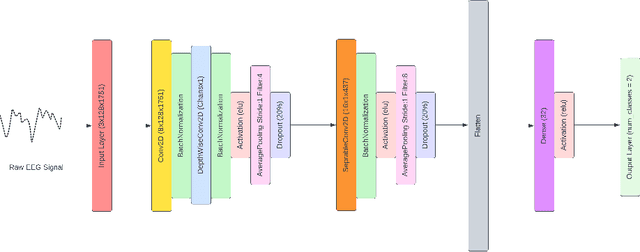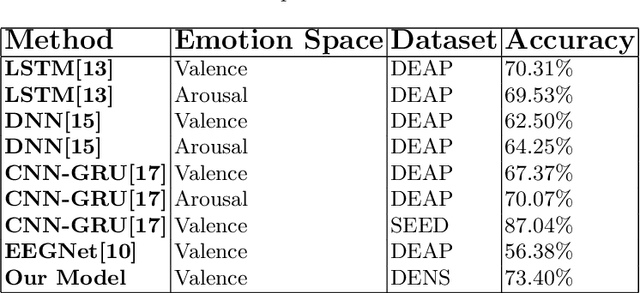Mohammad Asif
Proactive Emotion Tracker: AI-Driven Continuous Mood and Emotion Monitoring
Jan 24, 2024Abstract:This research project aims to tackle the growing mental health challenges in today's digital age. It employs a modified pre-trained BERT model to detect depressive text within social media and users' web browsing data, achieving an impressive 93% test accuracy. Simultaneously, the project aims to incorporate physiological signals from wearable devices, such as smartwatches and EEG sensors, to provide long-term tracking and prognosis of mood disorders and emotional states. This comprehensive approach holds promise for enhancing early detection of depression and advancing overall mental health outcomes.
Inter Subject Emotion Recognition Using Spatio-Temporal Features From EEG Signal
May 27, 2023


Abstract:Inter-subject or subject-independent emotion recognition has been a challenging task in affective computing. This work is about an easy-to-implement emotion recognition model that classifies emotions from EEG signals subject independently. It is based on the famous EEGNet architecture, which is used in EEG-related BCIs. We used the Dataset on Emotion using Naturalistic Stimuli (DENS) dataset. The dataset contains the Emotional Events -- the precise information of the emotion timings that participants felt. The model is a combination of regular, depthwise and separable convolution layers of CNN to classify the emotions. The model has the capacity to learn the spatial features of the EEG channels and the temporal features of the EEG signals variability with time. The model is evaluated for the valence space ratings. The model achieved an accuracy of 73.04%.
Emotion Recognition With Temporarily Localized 'Emotional Events' in Naturalistic Context
Oct 25, 2022



Abstract:Emotion recognition using EEG signals is an emerging area of research due to its broad applicability in BCI. Emotional feelings are hard to stimulate in the lab. Emotions do not last long, yet they need enough context to be perceived and felt. However, most EEG-related emotion databases either suffer from emotionally irrelevant details (due to prolonged duration stimulus) or have minimal context doubting the feeling of any emotion using the stimulus. We tried to reduce the impact of this trade-off by designing an experiment in which participants are free to report their emotional feelings simultaneously watching the emotional stimulus. We called these reported emotional feelings "Emotional Events" in our Dataset on Emotion with Naturalistic Stimuli (DENS). We used EEG signals to classify emotional events on different combinations of Valence(V) and Arousal(A) dimensions and compared the results with benchmark datasets of DEAP and SEED. STFT is used for feature extraction and used in the classification model consisting of CNN-LSTM hybrid layers. We achieved significantly higher accuracy with our data compared to DEEP and SEED data. We conclude that having precise information about emotional feelings improves the classification accuracy compared to long-duration EEG signals which might be contaminated by mind-wandering.
 Add to Chrome
Add to Chrome Add to Firefox
Add to Firefox Add to Edge
Add to Edge